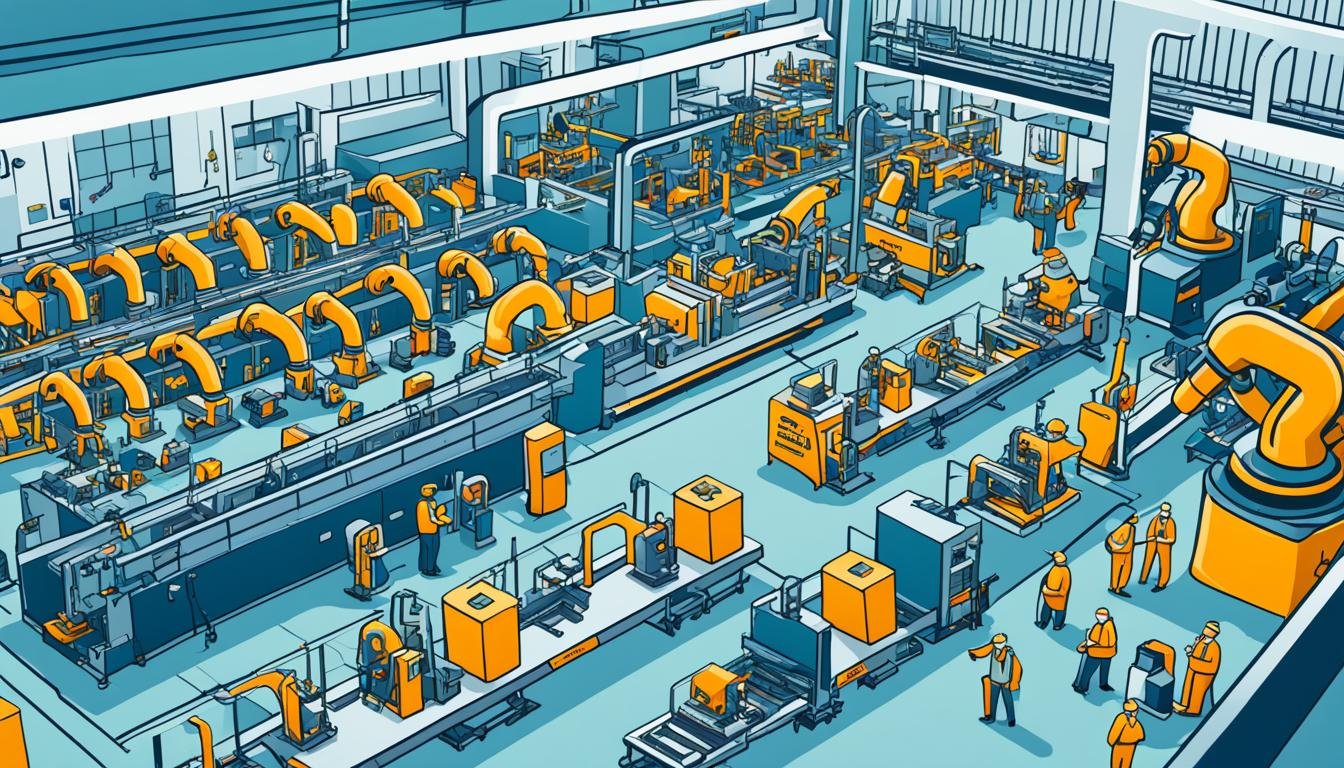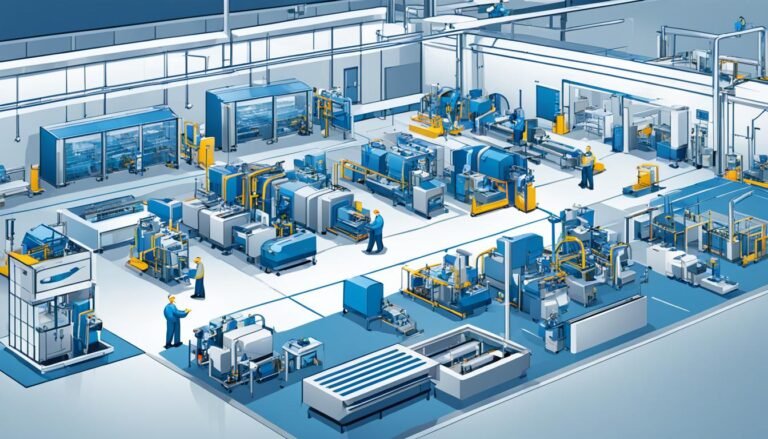Manufacturing Resource Planning: Optimize Production
Did you know that companies using Manufacturing Resource Planning (MRP II) can cut their production time by up to 30%? This shows how powerful MRP II is in making production better. In today’s fast-paced world, knowing how to use MRP II can make a big difference.
MRP II is more than a tool; it’s a strategy to improve how we plan, make, and manage production. It uses advanced methods and tools like the Master Production Schedule (MPS), Inventory Status Reports (ISR), and Bill of Materials (BOM). These help update production in real-time and allocate resources well to meet customer needs. By adopting this approach, companies can make better products, adapt to market changes, and reduce waste.
Key Takeaways
- Manufacturing Resource Planning (MRP II) can cut production lead times by up to 30%
- MRP II integrates materials, labor, and equipment to optimize manufacturing operations
- Tools like MPS, ISR, and BOM are essential for real-time inventory updates and efficient resource allocation
- MRP II ensures better adaptation to market changes and enhances product quality
- Implementing MRP II promotes lean manufacturing through effective waste reduction
Understanding Manufacturing Resource Planning
Manufacturing Resource Planning, or MRP II, is a system that combines traditional material planning with labor, machine capacity, and financial planning. It’s different from MRP, which mainly focused on managing inventory and the bill of materials. MRP II takes a broader view, adding demand forecasting, accounting, and capacity planning to the mix.
What is Manufacturing Resource Planning (MRP II)?
MRP II is a tool that helps improve productivity in manufacturing. It goes beyond just planning for materials. It also looks at labor, machine capacity, and finances. This approach helps manufacturers run smoother, waste less, and work more efficiently.
Key Benefits of MRP
MRP and its advanced version, MRP II, offer many benefits:
- Enhanced capacity planning through integrated scheduling
- Improved inventory control by ensuring materials are ready when needed
- Optimized production inventory, cutting down on excess stock and delays
- Accurate material requirements planning to avoid overstocking or running out
Historical Evolution of MRP Systems
MRP systems have changed a lot since they started. At first, they were just about managing inventory. Then, they added more complex tasks like planning for capacity and managing production inventory. This led to the advanced MRP II systems we use now.
These changes helped create Enterprise Resource Planning (ERP) systems. ERP systems handle everything from making products to managing customer relationships.
| Feature | MRP | MRP II |
|---|---|---|
| Focus | Inventory Control | Holistic Production Management |
| Components | Material Requirements | Material, Labor, Capacity, Financials |
| Capabilities | Basic Inventory Management | Comprehensive Capacity Planning and Production Inventory |
Production Planning and Scheduling
Planning and scheduling production is key to making workflows efficient and meeting market needs in manufacturing. Using strategic methods and advanced tools helps manufacturers boost their operations a lot.
The Role of Production Planning in Manufacturing
Production planning is crucial for managing the manufacturing process. It involves managing resources, balancing workloads, and setting deadlines. Making sure production runs smoothly is vital to stay competitive. With an ERP system, production planning gets better, improving communication and giving real-time updates.
Scheduling Techniques for Improved Efficiency
- On-Demand Production: Great for custom or small batches, this method makes items as orders come in. It cuts inventory costs and uses resources well.
- Series Production: For making lots of items, it involves planned production runs. It helps use labor and resources efficiently with large orders.
- Just-In-Time (JIT): This method cuts waste and boosts efficiency by matching production with demand closely. It means less storage is needed.
Using these scheduling methods helps manufacturers deliver on time and keep product quality high. It also makes workflows more efficient.
Tools and Software for Production Planning
ERP and APS (Advanced Planning and Scheduling) software are key for production optimization. They help coordinate production, offer strategic insights, and monitor operations in real-time.
| Feature | ERP Systems | APS Tools |
|---|---|---|
| Real-time Updates | Yes | Yes |
| Resource Allocation | Basic | Advanced |
| Production Optimization | Moderate | High |
| Demand Forecasting | Basic | Advanced |
| Cost Management | Yes | Yes |
These tools help manufacturers improve their production planning and respond quickly to market changes. By focusing on projects and using resources well, they can meet customer needs and control costs.
Inventory Management in Manufacturing
Managing inventory well is key in manufacturing. It makes sure production flows smoothly and keeps stock at the right levels. It also helps with managing resources and improving the supply chain, keeping supply and demand in balance.
Optimizing Inventory Levels
Optimizing inventory means adjusting stock to match production needs. It’s important to forecast demand accurately and keep enough safety stock. Using data analytics tools can give valuable insights, helping manage inventory better and control the shop floor.
Strategies for Effective Inventory Control
For good inventory control, strong strategies are needed. Some important methods include:
- Just-in-Time (JIT) Inventory: This approach cuts inventory costs by getting goods only when needed.
- ABC Analysis: It sorts inventory into three groups (A, B, C) by value and importance.
- Regular Audits: Periodic checks help keep inventory accurate and follow stock management rules.
Technology Solutions for Inventory Management
Technology is crucial for managing inventory today. SCM software gives real-time visibility and helps with resource allocation. These systems make managing the shop floor and the supply chain better. They help track inventory accurately, manage stock well, and keep production flowing without stops.
Integrating Manufacturing Resource Planning in Supply Chain Management
Adding Manufacturing Resource Planning (MRP) to supply chain management boosts efficiency. It makes the supply chain clearer, helps match demand with supply, and uses SCM software to its fullest.
Improving Supply Chain Visibility
Seeing the whole supply chain is key to tracking materials and products. MRP, when combined with advanced tracking, makes this clear. It watches over every step, from raw materials to the final product.
Coordinating Demand and Supply
Getting demand and supply in sync needs strong SCM software. This software helps forecast demand and plan for production. It lets companies adjust production based on market changes. This way, they can quickly meet customer needs without making too much or running out.
Advantages of Using SCM Software
SCM software has many benefits for managing the supply chain. It helps follow industry rules, cuts storage costs, delivers products on time, and makes working together better for everyone from suppliers to customers.
| Benefits of SCM Software | Description |
|---|---|
| Improved Compliance | Ensures adherence to regulatory standards and enhances operational transparency. |
| Reduced Storage Costs | Optimizes inventory management to minimize excess stock and associated costs. |
| Timely Product Delivery | Boosts on-time delivery rates by streamlining supply chain operations and scheduling. |
| Collaborative Efficiency | Fosters better coordination and collaboration among all stakeholders in the supply chain. |
Benefits and Challenges of Manufacturing Resource Planning
Exploring Manufacturing Resource Planning (MRP) shows its many advantages and challenges. We’ll look at the main benefits and common issues with MRP systems. Real-world examples will show how MRP has worked well in practice.
Key Benefits of MRP
MRP is great for making production cost estimates. It helps companies plan their budgets better and avoid spending too much. It also makes sure materials and labor are used well.
MRP helps improve manufacturing KPIs, making things faster and more efficient. With ERP solutions, businesses can work better together and make customers happier.
Common Challenges in Implementing MRP
Starting with MRP can be tough. Companies often have to change how they work to fit the new system. This can take a lot of time and money.
Getting data right is another big challenge. For MRP to work well, all the data must be correct and complete. Wrong or missing data can lead to bad decisions and less efficiency.
Case Studies and Successfull Stories
Toyota is a great example of how MRP can change things for the better. They made their production smoother and cut costs. Their advanced MRP system helped them improve and become a leader worldwide.
Boeing is another success story. They used a strong MRP system to better manage resources and improve efficiency. This led to more profits and staying competitive.
These stories show how MRP can help companies overcome problems and gain many benefits. Companies that invest in ERP solutions can see big improvements.
Conclusion
MRP is key to managing manufacturing well. It helps plan and schedule production, manage inventory, and improve supply chains. This approach is crucial for making operations smoother and more precise.
Technology has made MRP even more powerful. Now, companies can handle complex challenges better. By using modern MRP systems, they can match market needs with their resources. This leads to more efficient operations and faster production growth.
MRP connects what a company can do with what the market needs. This connection is vital for success and staying ahead in the market. The article shows how important MRP is for making manufacturing efficient. It highlights its role in strategic management in today’s fast-changing world.







